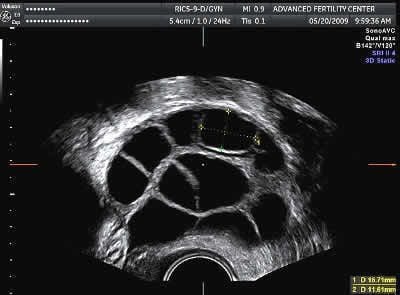
Controlled Ovarian Hyperstimulation for Unexplained Infertility
What is controlled ovarian hyperstimulation?
It involves the use of the same medications used for induction of ovulation in women that have anovulation. These drugs are used to stimulate development of multiple mature follicles and eggs in order to increase pregnancy rates with various infertility treatments.
Ultrasound of multiple follicles in a stimulated ovary
Who should be treated with controlled ovarian hyperstimulation?
This therapy is commonly used as infertility treatment for infertile couples. It is usually done in conjunction with intrauterine insemination, which increases success rates.
This treatment does not really correct any specific cause of infertility. Instead it is a "shotgun" approach to get multiple eggs and sperm together at the time of ovulation. This type of treatment has been shown to increase the monthly chances for a pregnancy as compared to timed intercourse alone in patients with unexplained infertility.
Ovarian stimulation with insemination should not be used with very low sperm concentration or very poor sperm motility, blocked fallopian tubes, or if the age of the female partner is over 41. This treatment is very unlikely to be effective in those situations.
Controlled ovarian hyperstimulation is also used to develop multiple mature follicles for in vitro fertilization cycles.Details about ovarian stimulation protocols for IVF
How is controlled ovarian hyperstimulation performed?
- The ovarian stimulating drug (Clomid or Femara or injectable FSH) is given early in the menstrual cycle in the same manner as described for induction of ovulation.
- Injectable FSH drugs (gonadotropins) are given as subcutaneous or intramuscular shots (we do sub-Q)
- Injectable FSH brand names in the U.S. are Follistim, Gonal-F, Bravelle, Menopur, Repronex
- Clomid or Femara (letrozole) pills are taken orally for 5 days (usually starting on day 5)
The way the medications are given are described on the pages that discuss subcutaneous FSH injections and intramuscular FSH injections.
General protocol for an ovarian stimulation treatment cycle:
- A baseline blood and ultrasound is usually done on day 2-4 of the menstrual cycle
- The medication is started soon after that
- Ultrasound and blood testing is done to monitor the response to the meds and follicle sizes
- An HCG trigger shot is given when the follicles are mature
- Sex or insemination are timed for about 36 hours after the trigger shot
A calendar and approximate schedule for an injectable FSH cycle
Learn about using Clomid pills for ovarian stimulation with unexplained infertility
Learn about using Femara pills for ovarian stimulation with unexplained infertility
Pregnancy success rates for controlled ovarian hyperstimulation
Success rates for controlled ovarian hyperstimulation with intrauterine insemination vary considerably and depend on the age of the woman, the total motile sperm count, the quality of the sperm, how long the couple has been trying to get pregnant, what the infertility factors are in the couple, etc. It is used most often in couples with unexplained infertility and in those with slight reductions in sperm counts ("mild" male factor).
Ovarian stimulation with gonadotropins (injectable FSH products like Pergonal or Follistim) plus intrauterine insemination gives pregnancy rates of about 5-15% per cycle (women 36 and younger) for unexplained infertility, as demonstrated in several published studies.
Success rates are lower if the woman is over age 36 or if there is a sperm problem - male factor infertility.
For women 40 and older, success rates with this form of infertility treatment are very low, and IVF should be considered relatively soon.
In general, this type of treatment is considered reasonable for about 3 cycles (in women under about 38), after which IVF is usually considered as the next step.
Cost of ovarian stimulation treatments
The costs associated with controlled ovarian hyperstimulation depend on the type and dose of medication required and the number of ultrasound and blood tests needed to adequately monitor the cycle. Doing intrauterine insemination with the cycle increases the success rate, as well as increasing costs.
Costs for fertility treatment cycles, including injectables with & without insemination
Categories
About the AFCC Blog
Welcome to the Advanced Fertility Center of Chicago’s blog! Here, you will find information on the latest advancements in fertility care and treatments, including IVF, IUI, third-party reproduction, LGBTQ+ family building, preimplantation genetic testing, and more. Since 1997, we’ve used our experience and continuous investment in the latest fertility technology to help thousands of patients grow their families. Contact us today for more information or to schedule a new patient appointment.


